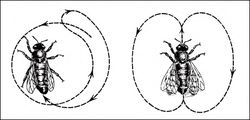Organisation of social behaviour patterns
Karl von Frisch, Konrad Lorenz and Nikolaas Tinbergen were awarded the behavioural patterns in animals. Von Frisch deciphered the intricate mid-flight dances of bees that they use for alerting the hive to flowers containing nectar. The round dance indicates flowers within 50 metres of the hive, which prompts the other bees to search the area to find it. When the nectar source is further than 50 metres away, the bee performs a waggle dance, where the direction of the movement indicates the direction of the flowers relative to the sun. From von Frisch’s painstaking studies, which included painting small coloured dots on the bees to identify individuals, it is clear that the bees do not learn how to do this dance nor understand it; this behaviour is somehow programmed genetically.
Von Frisch deciphered the intricate mid-flight dances of bees that they use for alerting the hive to flowers containing nectar. The round dance indicates flowers within 50 metres of the hive, which prompts the other bees to search the area to find it. When the nectar source is further than 50 metres away, the bee performs a waggle dance, where the direction of the movement indicates the direction of the flowers relative to the sun. From von Frisch’s painstaking studies, which included painting small coloured dots on the bees to identify individuals, it is clear that the bees do not learn how to do this dance nor understand it; this behaviour is somehow programmed genetically.
Lorenz’s work focussed teasing apart the instinctive behaviours of birds. Some types of behaviour appeared in birds that had hatched in incubators and had no experience to base their behaviour on. These were described as fixed action patterns. In other cases Lorentz observed that some experiences were vital for normal development and were imprinted irreversibly onto the bird’s behaviour. For example, a newly-hatched duck or goose will instinctively follow the first moving objects it sees and will continue to do so.
Tinbergen studied the stimuli that animals use as prompts for certain behaviour. These might include shape, size or colour of a rival or an egg. By using dummies and models, he could extrapolate these stimuli to extremes, which would correspondingly result in exaggerated behaviour from his subjects. A classic example is his study of what stimulus seagulls use to start pecking at their mother’s beak. Eventually he deduced that they were looking for a long, thin object with a (preferably red) spot, regardless of whether it was attached to their mother or not.
Further reading
http://www.nobelprize.org/nobel_prizes/medicine/laureates/1973/press.html
http://www.mpiwg-berlin.mpg.de/en/news/features/feature5
http://www.nytimes.com/1989/03/01/obituaries/konrad-lorenz-pioneer-in-study-of-animals-behavior-dies-at-85.html
http://dustincurtis.com/how_niko_tinbergen_reverse_engineered_the_seagull.html
Last edited: 27 August 2014 06:07
